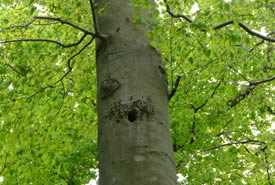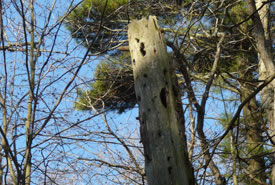Cavity tree

American beech tree cavity (Photo by Bernt Solymar)
Cavity trees are wildlife hot spots. These dead or dying trees serve many purposes to many different species. They are used by wildlife for nesting and raising young, protection from predators, a place to store food, hibernation and roosting.
What species use small tree cavities?
The size of the tree cavity influences what species will make use of it.
Cavities with small diameters attract smaller songbirds and mammals, such as:
- black-capped chickadee
- white-breasted nuthatch
- eastern bluebird
- white-footed deermouse
- red squirrel
What species use medium-sized tree cavities?
Medium-sized cavities will attract a wider range of species, including:
- wood duck
- eastern screech-owl
- pileated woodpeckers

Dead standing tree cavity (Photo by Bernt Solymar)
What species use large tree cavities?
Turkey vultures, barred owls, great horned owls and raccoons can be found in large tree cavities.

Turkey vulture nest in cavity tree (Photo by NCC)
How are tree cavities formed?
Some cavities form naturally with decay, while others are excavated by species, such as pileated woodpecker, hairy woodpecker and black-capped chickadee.
Signs of active tree cavities
While walking through Backus Woods, be sure to look out for active tree cavities. The following are all signs that a tree cavity is currently in use:
- fur or feathers
- smooth edges
- twigs and other nesting material at the entrance
- a lack of spider webs around the opening
Supported by the Weston Family Foundation.




